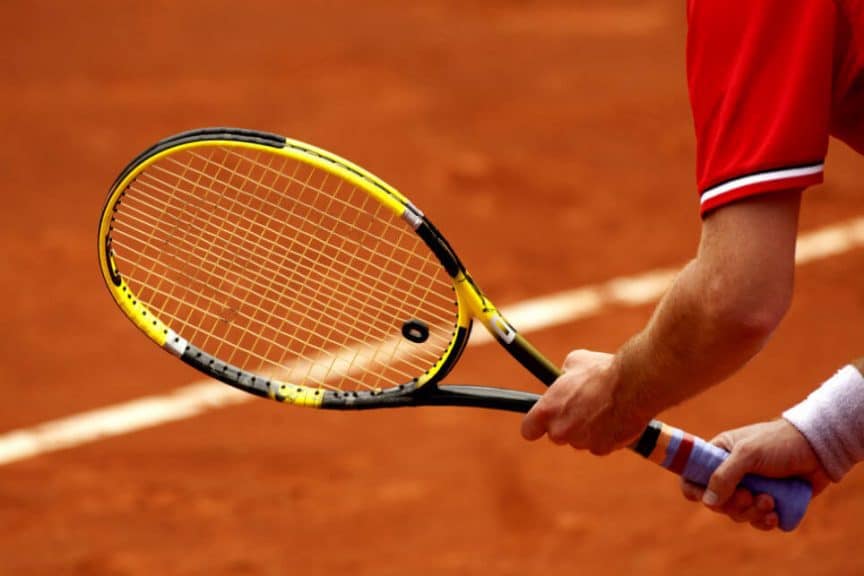Selecting Tennis Rackets
When selecting tennis rackets, keep in mind that there is no one size fits all approach. Every player has different skill sets, levels of experience, and varying needs in a racket.
Having said that, as a beginner there is no need to spend large amounts of money on a racket while you are developing your game. You can find a good racket for under $100 that will allow you to grow, even when you transition to more advanced play.
While there are many intricacies in racket design, there are essentially six things you need to consider when picking out a racket. First, you will need to decide on the material of the racket.
Racket Material
Most tennis rackets today are graphite or composites of graphite with other materials including fiberglass, copper, titanium, and tungsten. Aluminum rackets are still used as well, though they are less popular than graphite or composites, and are primarily used on entry level rackets.
Graphite is one of the most commonly used materials in rackets because it is relatively lightweight. It does tend to be relatively stiff, however, which results in more power but also more shock and vibration on the arm.
Boron/Kevlar is another popular material used in modern rackets. Commonly used in combination with graphite, it is even more lightweight than graphite, but also stiffer. Boron/Kevlar rackets provide great power but are very unforgiving on shots hit outside of the sweet spot.
For this reason, composites are used to make the racket more flexible. Composite tennis rackets tend to be a better choice for beginning players because they are more forgiving on mishits. As a beginner, you also generally want to gravitate towards a lighter racket to allow you to develop your swing motion.
Racket Head Size
There is a direct correlation between head size and power. The larger the head size, the more power a racket can generate. Typically, beginners tend to gravitate towards larger head sizes since they have larger sweet spots and require less effort to generate power.
On the other hand, smaller head sizes allow for more control since power is generated more by the player than the tennis racket. While more advanced players prefer control, there is an advantage to learning to play the game using a smaller racket head. It requires greater eye coordination to hit the sweet spot and allows players to fully develop their strokes without relying solely on the racket.
Racket head sizes range from 85 to 135 square inches, with 95 to 110 square inches being most common. A good balance between power and control is a mid-size or mid-plus frame in the middle of that size range. Mid-size and mid-plus tennis rackets tend to be a good choice for beginners as well as players of all levels.
Weight and Balance
The second aspect to consider is the weight and balance of the racket. A heavy tennis racket is more powerful and stable and will absorb more shock. A lighter racket is more maneuverable and allows a player to swing faster. Beginning players generally prefer lighter rackets because they are easier to maneuver.
In addition to overall weight, tennis rackets are also balanced either as head-heavy or head-light. Head-light tennis rackets are generally preferred by more advanced players since they allow for greater control and allow the player to generate power. Head-heavy rackets, on the other hand, generate greater power but sacrifice control and feel.
String Pattern Density
String pattern density is something that is often overlooked. There are essentially two types of string patterns: open and closed (dense). Open string patterns have fewer strings and are designed with wider spacing between.
The wider spacing allows the strings to deflect more and better grip balls on contact. This, in turn, helps produce greater spin during play. The downside to open string patterns is that the strings tend to not last as long and break more easily due to added friction.
Closed string patterns are more compact since they have more horizontal and vertical strings. Closed string patterns tend to provide better control than open patterns. This translates to some loss in power and spin but allows players to use more of their own force on groundstrokes.
Frame Stiffness
Frame stiffness refers to the amount a frame deflects when striking a ball. Generally speaking the stiffer the frame the more power a racket is able to generate. Like the head size and weight/balance, however, with greater power comes less control.
Beginning players, however, can benefit from stiffer frames since they have not yet fully developed their groundstrokes. While advanced players may find a stiff racket results in their shots carrying long, a beginner might find a stiff frame offers more power and greater control.
Players with shoulder or arm problems tend to benefit from a more flexible frame. This is because a more flexible frame will tend to absorb more shock during ball contact sending less vibration to a player’s arm. A flexible frame will have a stiffness rating of 65 or below.
Racket Grip Size
Choosing the correct grip size is perhaps the most important aspect of racket selection. A grip which is either too large or too small can result in slippage and even lead to unintended injury to the hand, wrist or elbow.
Grip sizes typically range from 4 inches for juniors to 4 3/4 inches for adults with a range of 1/8 increments in between. The European equivalent range is from 0 (4 inches) to 6 (4 3/4).
When selecting a grip size keep in mind that adding an overgrip will increase the thickness. If you are between two sizes and you prefer to use an overgrip, it’s usually best to select the smaller size to allow for the added layer.
To determine your grip size, hold the racket extended in front of you. Grip the racket as you normally would and slide the index finger of your other hand between the tip of your ring finger and palm. It should fit snug but not too tight, and there should not be any space between the index finger and the palm.
If you don’t have a racket available, here is a chart that should provide a good starting point based on your height.
Height to Grip Size Chart
Under 5’-0” = 4
5′-0″ to 5’-2” = 4 1/8
5’-3” to 5’-5” = 4 1/4
5’-6” to 5’-8” = 4 3/8
5’-9” to 5’-11” = 4 1/2
6’-0″ to 6′-2″ = 4 5/8
6′-3″ and Up = 4 3/4
Recommended Racket
As mentioned earlier, there is no need to spend a lot of money on a racket if you are new to the game of tennis. Of course, you want a reliable racket that you can use for many years and that will provide the performance to take you to more advanced levels.
You don’t necessarily want to just buy the cheapest racket you can find either. Many entry-level tennis rackets are just for recreational use and don’t provide the quality to help you develop your game. The racket should provide a solid level of performance and be durable enough to last for a few years.
HEAD MicroGel Radical: Beginners to Intermediate
The racket is available in a mid-plus (98 square inches) and oversize head size (107 square inches). The mid-size plus provides a bit more in terms of control, though not much is lost on the oversize. The larger head size is a more forgiving racket on shots hit outside the sweet spot and adds a bit more in terms of power.
HEAD’s MicroGel technology is built into the graphite frame to help absorb shock. The technology helps to uniformly absorb and distribute the impact load throughout the racket head. This results in good stability and comfort.
One thing I like about this racket is that it requires a moderate to full swing to generate power. Even as a beginner, you want to develop your stroke properly without relying too much on the racket itself. The oversize will generate a bit more power on its own, but the control is still there.
This is a relatively flexible racket, not too stiff. Combined with the MicroGel technology, this makes for a very comfortable racket. The frame offers good feel, control, and precision, something that should appeal to players at all levels.
You can find the HEAD MicroGel Radical tennis racket on Amazon: HEAD MicroGel Midplus Radical | HEAD MicroGel Oversize Radical.


